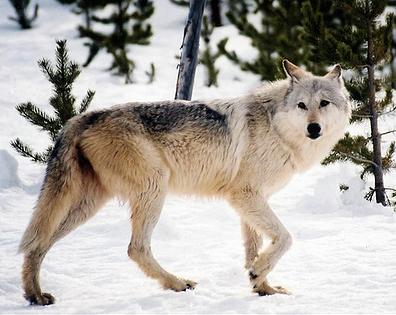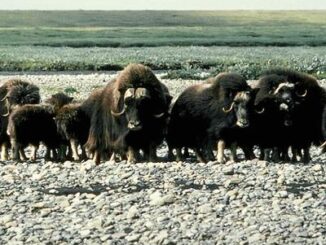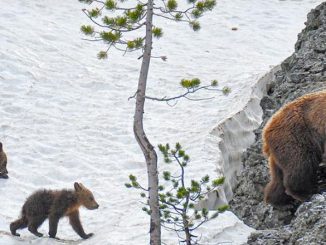
WASHINGTON, DC, November 7, 2020 (ENS) – To the dismay of conservationists, the U.S. Fish and Wildlife Service has opened hunting season on gray wolves across the United States by removing them from the national Endangered Species List.
U.S. Secretary of the Interior David Bernhardt announced October 29 that state and tribal wildlife management agency professionals will resume responsibility for sustainable management and protection of delisted gray wolves in states with gray wolf populations.
“Today’s action reflects the Trump administration’s continued commitment to species conservation based on the parameters of the law and the best scientific and commercial data available,” said Secretary Bernhardt. “After more than 45 years as a listed species, the gray wolf has exceeded all conservation goals for recovery. Today’s announcement simply reflects the determination that this species is neither a threatened nor endangered species based on the specific factors Congress has laid out in the law.”

“President Trump’s Administration has focused on proactive measures, including partnerships with organizations, to ensure listed species flourish to the point of recovery,” said U.S. Fish and Wildlife Service Director Aurelia Skipwith. Sworn in last December, she is the first Black woman to hold this job.
“Today is a win for the gray wolf and the American people,” Skipworth said. “I am grateful for these partnerships with States and Tribes and their commitment to sustainable management of wolves that will ensure the species’ long-term survival following this delisting.” The Fish and Wildlife Service will continue to monitor the species for five years.
Farmers, cattlemen and ranchers applauded the delisting as they blame wolves for livestock losses, but conservationists had dire warnings about the consequences, and a coalition of conservation groups is preparing a lawsuit aimed at reversing the rule.
A coalition of Western wolf advocates announced Friday that they would challenge the agency’s decision to “prematurely” strip wolves of federal protections in the contiguous 48 states, in violation of the Endangered Species Act. This notice of intent to sue starts a 60-day clock, after which the groups will file a lawsuit in federal court.
“Given that gray wolves in the lower 48 states occupy a fraction of their historical and currently available habitat, the Fish and Wildlife Service determining they are successfully recovered does not pass the straight-face test,” said John Mellgren, an attorney with the nonprofit Western Environmental Law Center based in Eugene, Oregon, which will represent the eight plaintiff groups.
The coalition launching the legal challenge includes WildEarth Guardians, Western Watersheds Project, Cascadia Wildlands, Klamath-Siskiyou Wildlands Center, Environmental Protection Information Center, The Lands Council, Wildlands Network, and Klamath Forest Alliance.
“While the Trump administration may believe it can disregard science to promote political decisions, the law does not support such a stance. We look forward to having a court hear our science-based arguments for why wolves are not recovered throughout the contiguous U.S. and need Endangered Species Act protections to fully recover,” Mellgren said.
The Western Environmental Law Center points to the most recent data from the U.S. Fish and Wildlife Service and its state partners showing an estimated 4,400 wolves inhabit the western Great Lakes states, but that there are only 108 wolves in Washington state, 158 in Oregon, and just 15 in California.
The Fish and Wildlife Service is publicizing different numbers. The agency says that in total the gray wolf population in the lower 48 states is more than 6,000 wolves, “greatly exceeding the combined recovery goals for the Northern Rocky Mountains and Western Great Lakes populations.”
The Fish and Wildlife Service concludes that because in its belief there are sufficient wolves in the Great Lakes states, it does not matter that wolves in the West are not yet recovered, the conservationists point out. They say that the Endangered Species Act demands more, including restoring the species in the ample suitable habitats afforded by the wild public lands throughout the West.
“Wolves are a keystone species whose presence on landscapes regulates animal populations and improves ecosystem health – something the Service has acknowledged for at least 44 years,” said Kelly Nokes, an attorney at the Western Environmental Law Center.
“Allowing people to kill wolves in Idaho, Wyoming, and Montana has already stunted recovery in those states,” said Nokes. “Applying this same death sentence to wolves throughout the contiguous U.S., would nationalize these negative effects, with potentially catastrophic ripple effects on ecosystems wherever wolves are found today.”
Copyright Environment News Service (ENS) 2020. All rights reserved.
© 2020, Environment News Service. All rights reserved. Content may be quoted only with proper attribution and a direct link to the original article. Full reproduction is prohibited.



